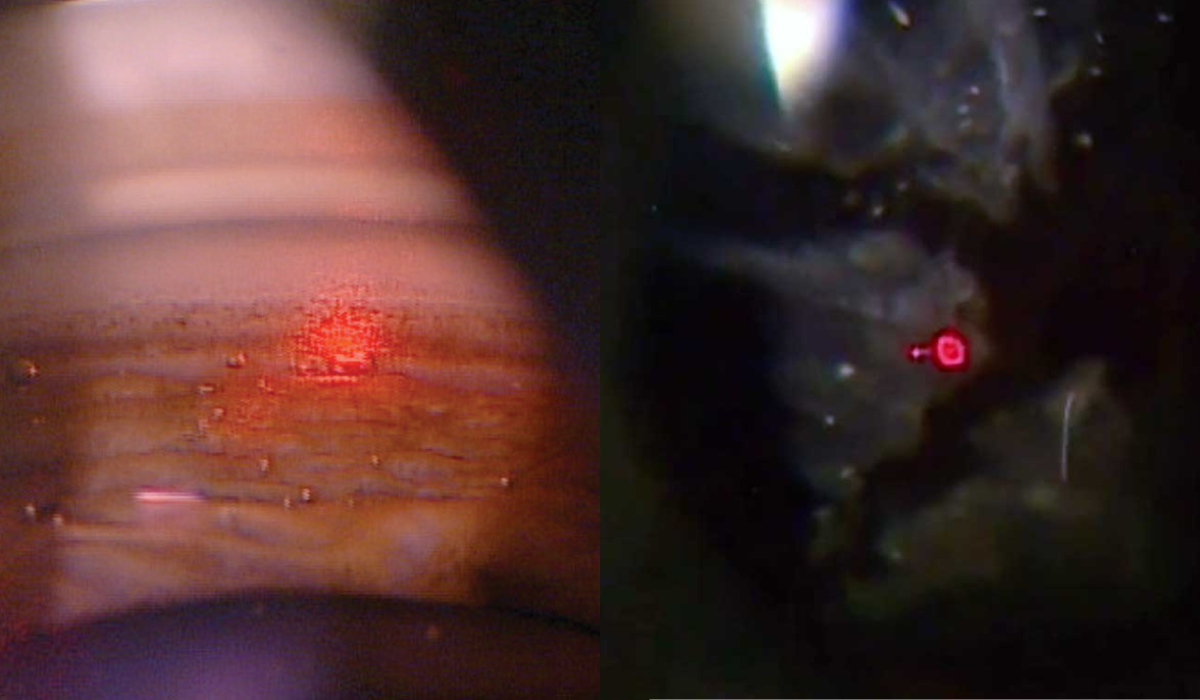 |
Alabama's laser bill would allow optometrists to perform SLT (left) and YAG capsulotomy (right), as well as remove lid lesions. Photos: Nathan Lighthizer, OD. Click image to enlarge. |
After years of advocacy work, negotiation and legislative efforts, largely led by the Alabama Optometric Association (ALOA), a laser bill was introduced in the state on April 20 that would add several procedures to the practice scope. If the bill ultimately passes, Alabama would become the 11th state to allow ODs to perform some laser procedures, the 5th since 2021.
On May 3, House Bill 349, sponsored by Representative Danny Garrett, passed the Alabama House Health Committee with a vote of 7-5. One week later, on May 9, the legislation faced a third reading before the Alabama House and received overwhelming bipartisan support, passing with a vote of 78-6. Next Wednesday, the bill will go before the Senate Health Committee.
“This bill will bring the level of practice of optometry to the level of training at optometry schools throughout the United States, and, of course, the UAB School of Optometry,” says Howard Day, OD, president of the ALOA.
The passage of HB 349 would permit Alabama ODs to perform the following under the circumstances outlined in the legislation:
- Skin lesion removal (using topical or subcutaneous anesthetics)
- Intense pulsed light treatment
- YAG laser capsulotomy and selective laser trabeculoplasty (SLT)
- Intravenous injection for the purpose of performing fluorescein angiography “at the direction of a licensed physician as part of an active treatment plan in a setting where a licensed physician is immediately available.”
- Approved vaccinations during health crises
To be authorized to perform laser capsulotomy and trabeculoplasty, the bill states that Alabama optometrists must have completed at least 10 procedures on live patients under the direct supervision of a state-licensed physician specializing in ophthalmology. The OD must have also completed 36 hours of board-approved specialized training in the two laser procedures.
A Long Time Coming
The first scope bill filed by the ALOA was back in 2019, which was ultimately shot down due to concerns regarding OD training. More recently, in March 2022, another scope bill introduced by the ALOA passed the Senate with a vote of 17 to 12. However, the bill did not pass the House Health Committee, ending its run that session.
At the time, Caleb Gardner, OD, former president of the ALOA, commented that, “The session ended, and we didn’t get a vote in the House because we ran out of time, which ultimately is because of the power of our opposition. There was opposition from medicine, ophthalmology and the medical association of the state of Alabama, who all fought really hard,” Dr. Gardner noted.
This year, prior to the bill’s official introduction, the ALOA took part in a six-week-long negotiation process overseen by leadership in the House of Representatives to come to an agreement on the provisions. The association reports that in the end, political ophthalmology walked away from the table, unwilling to compromise in any way on the procedures outlined in the legislation.
Because of this, Alabama’s House Health chairman, Representative Paul Lee, decided to write his own bill—HB 349—which optometry ultimately accepted to honor the work of House leadership, who initiated the negotiation process.
But not all parties are happy; MD groups are aggressively fighting back against the legislation. However, with several years of experience under their belts advocating for and negotiating this bill, the ALOA is hopeful that state senators will recognize the importance of allowing Alabama ODs to perform procedures that have already been completed more than 100,000 times by optometrists in other states.
“I’m extremely proud of the ALOA scope expansion team, which we call the Hornets Nest,” says Dr. Day. “This team has put countless hours in leading our grassroots efforts. The ALOA Hornets continue to swarm!”
Dr. Day ends with an affirming message: “Lasers in ’23!”
California Bill Hearings Postponed
While things heat up in Alabama’s battle for lasers, California’s scope bill takes a backseat—but only temporarily.
Coming back from last year’s loss, scope expansion advocates in California introduced an identical laser bill again this past March. The bill proposes that under the clinical circumstances outlined in the bill, ODs in the state should be allowed to perform SLT, peripheral iridotomy, posterior capsulotomy, lesion removal, corneal crosslinking and eyelid injections.
Again sponsored by Assemblymember Evan Low, AB 1570 was scheduled to be heard by the Assembly Business and Professions Committee on April 25. However, due to Governor Newsom’s concerns regarding training requirements—the same reason he chose to veto the bill last session—the author pulled the bill prior to the hearing to allow for more time to work on the amendments necessary to strengthen the governor’s support.
California’s ongoing fight for optometric laser authority is certainly not over; since AB 1570 is a two-year bill, it will be eligible for a hearing again in January. Until then, the California Optometric Association and other proponents of the bill will be reworking the bill’s terms to address the concerns while still retaining the language necessary to adequately expand the practice scope for California optometrists.


